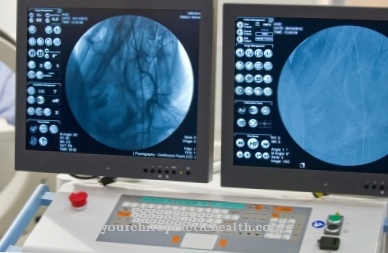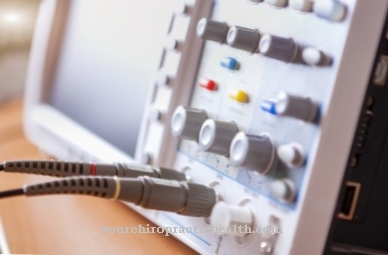Of the ELISA test is a medical laboratory examination which results in a so-called antigen-antibody reaction. Different antigens that play a role in human or veterinary medicine can be tested. In Germany, only accredited laboratory institutes are commissioned to carry out the test.
What is procedure?

ELISA is the abbreviation for Enzyme Linked Immuno Sorbent Assay. It is therefore an English-language name, but it has become established in German medical usage.
The ELISA test is one of the so-called immunological methods within medical laboratory tests. The test procedure can be used to detect protein molecules in a wide variety of body fluids. The detection of these molecules in turn allows conclusions to be drawn about certain diseases or clinical pictures, which is why doctors also make their diagnosis dependent on the result of such an ELISA test. The test procedure is therefore very important in everyday clinical practice, outpatient or inpatient.
The corresponding body fluids, for example whole blood or fluids from joints, are sent directly to the laboratory after they have been taken from the patient. The samples are usually very urgent, because the native material is considered sensitive and should be examined as soon as possible. So-called overlaid samples can lead to false negative results because the pathological proteins to be detected have meanwhile been reduced or completely broken down. So-called pre-analysis plays an important role in ELISA; suspicious or negative results should be repeated again if there are clinical symptoms.
Function, effect & goals
Test tubes and so-called microtiter plates are essential for correct testing in an accredited medical laboratory. These plates with fine, semi-concave indentations are made of special plastic and are each coated with a very specific antibody.
If the antigen to be detected is present in a body fluid to be examined, a specific antigen-antibody reaction occurs according to the so-called lock and key principle. The laboratory staff can enter the sample material into the plates either manually using pipettes or fully automatically. In modern medical laboratory institutes only fully automated systems are used to carry out ELISA diagnostics.
However, these must be monitored by trained personnel, medical-technical laboratory assistants. The so-called internal and external quality control is also the responsibility of the laboratory staff, superordinate to the medical staff for laboratory medicine, infection epidemiology and microbiology. After the first attempt, i.e. after the material has been pipetted onto the plates, the specific antigens in the sample, if present, have already bound to the antibodies on the plastic plate.
This is followed by a wash cycle with physiological saline solution in order to remove disruptive factors such as undesired antigens or proteins from the batch. This step is very important to avoid false positive reactions. A supposedly positive result misinterpreted by the laboratory can under certain circumstances have fatal consequences for a patient. In the second step of the investigation, a further antibody, which is linked to an enzyme, is added. This labeled antibody also binds to the antigen.
In a third and final step, a special dye is added in a defined amount, which is broken down to a greater or lesser extent by the remaining enzyme residues. Only that enzyme can be broken down which has not previously been bound to the antigen together with the antibody. The free enzyme is able to cleave the added dye. The exact amount of the split dye can be determined with a further medical laboratory method, the so-called photometry. This enables an exact conclusion to be drawn as to whether and how much antigen is present in a sample material.
The ELISA test is not only used for the initial diagnosis or to substantiate suspected diagnoses in certain diseases and clinical pictures, but also to monitor their progress. If the antigen concentration in the test becomes lower in the course of therapy, the therapy is considered successful.
You can find your medication here
➔ Medicines to strengthen the defense and immune systemRisks, side effects & dangers
The ELISA test is particularly informative through the detection of antigenic structures in body fluids. The test allows a so-called qualitative, but also semiquantitative and quantitative statement about the presumed presence of certain antigens in body fluids.
Whole blood cannot be used for the examination, only blood serum. A direct test on the patient, for example from the capillary blood of the fingertip, is therefore, as with some other serological tests, not possible to date. In human medicine, the ELISA test is primarily used to detect antigens in bacterial, viral or fungal infections. In addition, all positive results of the hepatitis serology are checked again with an ELISA test as standard.
Certain hormones, such as the pregnancy hormone HCG, can also be determined with the ELISA test. If certain complications occur during pregnancy, precise knowledge of the concentration of the pregnancy hormone in the blood is very helpful diagnostically and therapeutically. Another area of indication for the test is the detection of so-called paraproteins in the urine, as they occur, for example, in various tumor diseases such as multiple myeloma.
The ELISA test is still carried out in many laboratory institutes today, but is considered out of date by experts. The enzyme-linked immune reaction in the ELISA test has been increasingly replaced in recent years by radioactively labeled antibodies that provide even better quantitative results. These tests are also known as RIA, Radio Immunoabsorbent Assay. Further specific further developments of the ELISA are light-chemical methods such as luminescence or fluorescence.

























.jpg)

.jpg)
